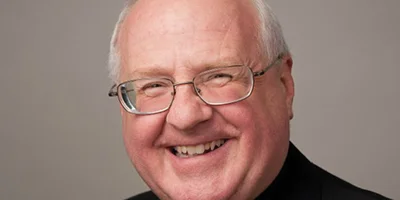
Father Mark Goldasich is the pastor of Sacred Heart parish in Tonganoxie. he has been editor of the Leaven since 1989.
by Father Mark Goldasich
It’s funny how one little word can change everything.
Last December around the celebration of the Immaculate Conception, a mom approached me after Mass with a huge grin on her face. I’d mentioned during the announcements that we had a display of rosaries at the front of church. I invited folks to spend a little time looking over the great variety of styles for this familiar prayer.
The mom said that her young son nudged her and had a confused look on his face. When she asked what was wrong, he said, “Why did Father Mark say there was a display of groceries in church?” Yup, one little word can change everything!
Late in December while on the Plaza in Kansas City, Missouri, my Jesus Caritas prayer group popped into Barnes & Noble to browse for a while. When I heard my name, I looked up to see Father Phil Winkelbauer waving a book at me. Knowing that my “hobby” is decluttering, he said, “Here’s another book for you.” I laughed and ignored him, but later wandered over to peek at the book for myself.
It was called “The Life-changing Magic of Tidying Up,” by Marie Kondo. I snickered to myself as I read the subtitle: The Japanese Art of Decluttering and Organizing. Yeah, right. Much to my surprise a little sticker on the cover mentioned that this was a New York Times Best Seller with over 2 million copies sold worldwide. Really?
I decided to skim a few pages. Before I knew it, I was engrossed. I didn’t buy the book, though, because I was sure that my priest buddies would give me grief. But the book continued to haunt me until I finally ordered a copy. What originally piqued my interest in the bookstore only deepened as I made my way through the 200 or so pages of this little volume.
It seems strange to say this, but using the word “tidying” instead of “decluttering” has magically made a difference in my outlook toward my possessions. Kondo has shifted my mindset from “What do I want to get rid of?” to “What do I want to keep?” And the “yardstick” for deciding is to hold each item in my hand and ask this simple question: Does this spark joy? If it does, it’s a keeper. If not, out it goes.
Obviously, “out” doesn’t mean just toss it into the trash. If it’s something that someone else can use, it goes into a donate bag.
The author writes: “To truly cherish the things that are important to you, you must first discard those that have outlived their purpose.” Then she mentions something that has made parting with things much easier: “Let them go, with gratitude.” Trust me, this works.
Let me give you a silly example. This will probably come as no shock to anyone who knows me, but I’m not much of a clothes horse. In fact, I usually wear my poor clothes until they wear out. I had a pair of socks with a small hole in the bottom. Every time I took them out of the drawer, I noticed that the hole was getting worse. But I continued to wear them (even though, go figure, I have plenty of socks — some brand-new — in the drawer).
Taking Kondo’s advice, when I grabbed this pair of socks the other day, I stopped putting them on. I said a prayer of thanksgiving that they had served me well for such a long time . . . and put them in the trash. I can’t tell you how good that felt.
I’ve started to do the same with other clothes in my closet. I’ve taken out shirts that no longer fit — but that I’ve kept for some unknown reason — said a prayer of thanks for the use I did get out of them and placed them in a donation bag. After the clothes, I’ll move on to tidy my books this Lent.
Much as I hate to admit it, Kondo is right when she writes: “Putting your house in order is fun! The process of assessing how you feel about the things you own, identifying those that have fulfilled their purpose, expressing your gratitude, and bidding them farewell is really about examining your inner self, a rite of passage to a new life.”
In my book, that’s not magic. It’s a miracle!


